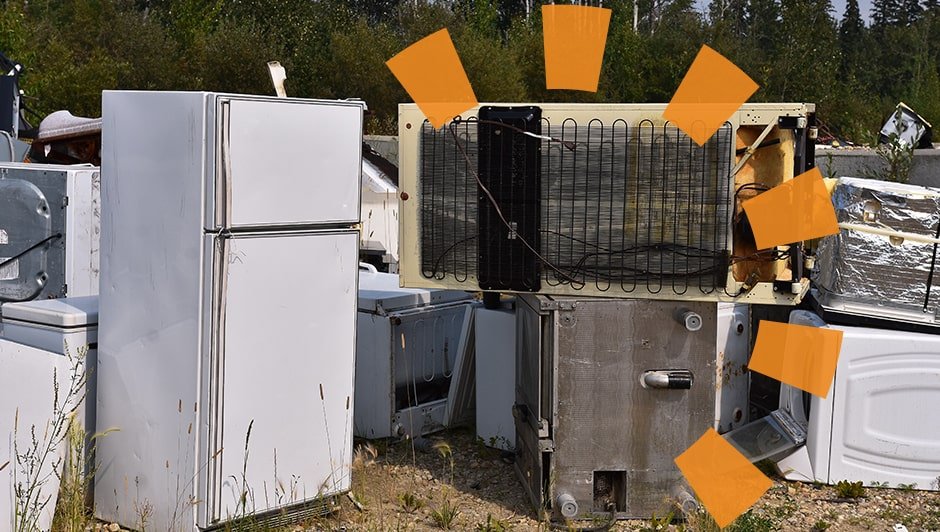The Appliance Lifecycle: Understanding the End-of-Life Challenge
Every appliance, from the humble toaster to the industrial-sized refrigerator, eventually reaches the end of its useful life. When that time comes, homeowners face the daunting task of disposal—a process far more complex than simply placing items at the curb. Modern appliances contain intricate combinations of materials, including metals, plastics, glass, and potentially hazardous components, making their disposal a matter requiring careful consideration. The average household appliance weighs between 100 and 300 pounds, presenting immediate physical challenges for homeowners attempting removal without proper equipment or expertise. Furthermore, municipal regulations increasingly restrict how these items can be discarded, reflecting growing awareness of their environmental impact.
Transitioning to the broader perspective, the challenge of appliance disposal extends beyond individual households to encompass community-wide waste management concerns. Landfills across the country face space limitations, and bulky appliances consume disproportionate amounts of valuable room. Additionally, many appliances contain refrigerants, oils, and other substances that can harm the environment if not handled properly. These realities have given rise to specialized appliance disposal services designed to address the unique challenges posed by end-of-life appliances. These services bridge the gap between consumer need and environmental responsibility, offering solutions that prioritize convenience, compliance, and sustainability. Understanding the full lifecycle of appliances—from purchase to disposal—helps consumers appreciate the importance of utilizing professional disposal services when their appliances reach retirement age.
The Heavy Burden: Challenges in Appliance Disposal
Attempting to dispose of appliances independently presents homeowners with numerous obstacles that extend well beyond the obvious physical challenges. The sheer weight and bulk of items like refrigerators, washing machines, and stoves require specialized equipment and multiple people to move safely. Many homeowners discover too late that their vehicles cannot accommodate these large items, or that attempting to transport them risks damage to both the appliance and the vehicle. Additionally, navigating local regulations regarding appliance disposal proves confusing for most consumers, with requirements varying significantly between municipalities. Some areas prohibit appliances in regular trash collection, while others mandate specific preparation methods before disposal, such as removing doors from refrigerators for safety reasons.
Transitioning to the logistical considerations, the disposal process becomes increasingly complex when factoring in the various components within modern appliances. Many units contain hazardous materials requiring special handling, including refrigerants like Freon in cooling appliances, mercury in some switches, and oils in compressors. Federal and state regulations often require certified technicians to remove these substances before disposal, adding another layer of complexity for the average homeowner. Furthermore, the environmental consciousness of many consumers creates a desire to dispose of appliances responsibly, yet identifying recycling facilities that accept large appliances proves challenging in many areas. These combined challenges—physical, logistical, regulatory, and environmental—create a compelling case for utilizing professional appliance disposal services equipped to handle every aspect of the process efficiently and responsibly.
Environmental Responsibility: The Green Side of Appliance Disposal
The environmental impact of improper appliance disposal cannot be overstated, as these items contain both valuable resources and potentially harmful substances. When appliances end up in landfills, the metals, plastics, and glass they contain represent wasted resources that could otherwise be recycled and repurposed. A single refrigerator, for example, contains approximately 100 pounds of steel, 25 pounds of plastic, and 3 pounds of glass—all materials that can be recovered through proper recycling processes. Additionally, many appliances contain hazardous components that can leach into soil and groundwater if disposed of improperly. Refrigerators and air conditioners contain chlorofluorocarbons (CFCs) and hydrochlorofluorocarbons (HCFCs), substances known to deplete the ozone layer if released into the atmosphere.
Transitioning to the positive environmental outcomes of proper disposal, professional appliance disposal services play a crucial role in minimizing the ecological footprint of retired appliances. These services follow established protocols for safely removing and handling hazardous materials, ensuring they don’t harm the environment. The metal components of appliances are typically separated and sent to recycling facilities, where they can be melted down and used to manufacture new products, reducing the need for virgin materials and the energy required to extract them. Plastic components are sorted by type and recycled appropriately, while glass is processed for reuse in various applications. By diverting appliances from landfills and maximizing material recovery, professional disposal services significantly reduce greenhouse gas emissions associated with both waste decomposition and new product manufacturing. This comprehensive approach to appliance disposal transforms what would be waste into valuable resources, embodying the principles of a circular economy and responsible environmental stewardship.
The Professional Process: How Appliance Disposal Services Work
Professional appliance disposal services follow a systematic process designed to maximize convenience for customers while ensuring compliance with environmental regulations. The journey typically begins with a simple phone call or online inquiry, during which customers describe the appliances they need removed and provide details about access and location. Reputable companies offer transparent pricing based on factors such as appliance type, size, and quantity, often providing quotes without obligation. Once scheduled, the disposal team arrives at the designated time with specialized equipment, including dollies, straps, and vehicles capable of safely transporting heavy items. The professionals handle all aspects of removal, from disconnecting appliances (when appropriate) to navigating tight spaces and stairs, eliminating physical risks for homeowners.
Transitioning to the post-removal phase, professional appliance disposal services implement careful sorting and processing procedures to maximize environmental responsibility. Upon collection, appliances are transported to specialized facilities where they undergo initial assessment. Technicians identify and safely remove any hazardous materials, such as refrigerants, oils, and mercury-containing components, ensuring these substances are handled according to regulatory requirements. The remaining materials are then separated into recyclable categories—metals, plastics, and glass—with each category directed to appropriate recycling facilities. Metals like steel, copper, and aluminum are particularly valuable, often comprising up to 75% of an appliance by weight. These metals are shredded, sorted, and sent to manufacturers for reuse in new products. For environmentally conscious consumers seeking responsible disposal options, appliance disposal services offer a comprehensive solution that handles every aspect of the process while prioritizing sustainability and regulatory compliance. This professional approach ensures that appliances are disposed of safely, efficiently, and with minimal environmental impact.
Choosing Your Disposal Partner: Selecting the Right Appliance Disposal Service
Selecting a reputable appliance disposal service requires careful consideration of several key factors to ensure a positive experience and environmentally responsible outcome. Begin by verifying that potential companies maintain proper licensing and insurance to operate in your area. Licensing demonstrates compliance with local regulations, while adequate insurance protects you from liability in case of accidents or property damage during the removal process. Experience represents another critical criterion—companies with established track records in appliance disposal will have refined their processes for maximum efficiency and environmental responsibility. Additionally, look for providers who offer transparent pricing with no hidden fees, providing clear quotes based on the type and quantity of appliances rather than vague estimates that could increase unexpectedly.
Transitioning to the evaluation process, environmental commitment should be a central consideration when selecting an appliance disposal service. Reputable companies will openly discuss their recycling processes and environmental practices, including how they handle hazardous materials and maximize material recovery. Ask potential providers about their downstream partners—where do they send materials for recycling, and what percentage of each appliance do they typically divert from landfills? Customer reviews and testimonials offer additional insights into a company’s reliability and quality of service. Platforms like Google, Yelp, and the Better Business Bureau provide unbiased feedback from previous clients regarding punctuality, professionalism, and overall satisfaction. When contacting potential providers, pay attention to their responsiveness and willingness to answer your questions thoroughly. A company that communicates clearly and transparently about their processes is more likely to deliver a satisfactory experience. By carefully evaluating potential providers based on these criteria, you can select an appliance disposal service that not only removes your unwanted appliances efficiently but also ensures they are processed in an environmentally responsible manner.











